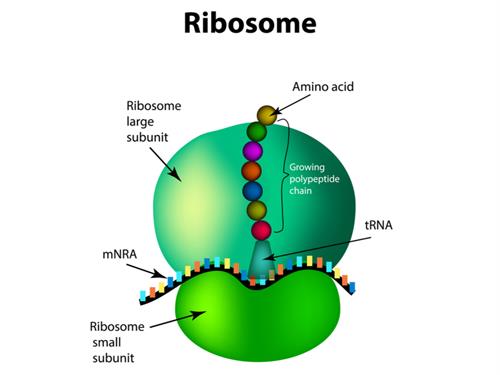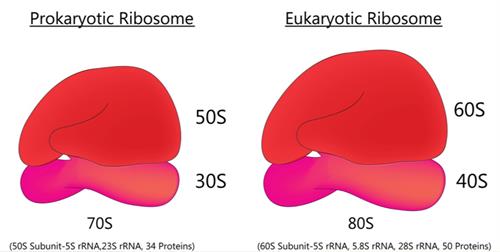PDF chapter test TRY NOW
Proteins are large, complex molecules that play a variety of important roles in the human body. They are essential for the structure, function, and regulation of the body's tissues and organs, and they do the majority of their work in cells. Synthesis of proteins inside a cell is done by Ribosomes.
1. Discovery: Ribosomes are granular structures first observed under the electron microscope in animal cells by George Palade in \(1953\). Robinson and Brown discovered it in plant cells for the first time in bean roots in \(1953\).
2. Location: They are dispersed in the cytoplasm, with a few bound to the endoplasmic reticulum's surface.
3. Composition: They are made up of proteins and ribonucleic acid (RNA). So, it's known as ribonucleoprotein.
4. Function: Ribosomes are considered, aprotein synthesis site. Because they provide space and enzymes for protein synthesis in the cell.

Parts of ribosome: Ribosomes has both smaller sub unit and a larger sub unit. They are classified as
- \(70S\) ribosomes
- \(80S\) ribosomes
Both forms of ribosomes have different types of rRNA and proteins as subunits.

\(70S\) ribosomes | \(80S\) ribosomes |
Ribosome type present in prokaryotes. Example; bacteria. | Ribosome type present in eukaryotes. Example; plant and animal cell. |
| It consists of \(2\) subunits, \(50S\) larger subunit and \(30S\) smaller subunit. | It consists of \(2\) subunits, \(60S\) larger subunit and \(40S\) smaller subunit. |
| Also be found in eukaryotic cells mitochondria and plastids. | Found only in eukaryotic cells except mitochondria and plastids. |
Theodor (The) Svedberg was born in Sweden on August \(30\), \(1884\). Svedberg’s work has mainly been concerned with colloids and macromolecular compounds. For the study of sedimentation he constructed his well-known ultracentrifuge, where large molecules in solution, such as proteins, carbohydrates, and high polymers have been investigated. For his work on the disperse systems he received the Nobel prize in \(1926\). The sedimentation coefficient is measured using Svedberg unit (S). This unit is named after Theodor Svedberg for his work on measurement of particles using sedimentation with an ultracentrifuge.

Theodor (The) Svedberg
Sedimentation co-efficient is a calculation of particle size, shape and density indirectly by measuring sedimentation rate under a centrifuge.
Why do ribosomes having subunits as \(30S\) and \(50S\) called \(70S\) ribosomes instead of \(80S\) ribosomes?
\(30S\) + \(50S\) should be equal to \(80S\), but why \(70S\) for ribosomes? Because \(70S\) is not derived from the addition of subunits. For the measurement of the ribosomes' size, the sedimentation of ribosomes is measured in an ultracentrifuge using a scale. Subunits are sedimented at the top portion of the scale while measured separately. Smaller subunits are sedimented at the \(30S\) and larger subunits are sedimented at the \(50S\) . The entire unit of ribosomes are sedimented at \(70S\) part of the scale. Hence the \(70S\) ribosomes have subunits as \(30S\) and \(50S\). The concept is similar to that of \(80S\) ribosomes whose subunits are \(60S\) and \(40S\).
Interesting facts about Ribosomes:
- Ribosomes are not present immature sperm and red blood cells.
- It's an organelle that doesn't have a membrane.
- They are found in both prokaryotes and eukaryotes.
- Suppose the ribosomes are studded on the endoplasmic reticulum membrane, it's known as the rough endoplasmic reticulum (RER).
Reference:
https://www.nobelprize.org/prizes/chemistry/1926/svedberg/biographical/
